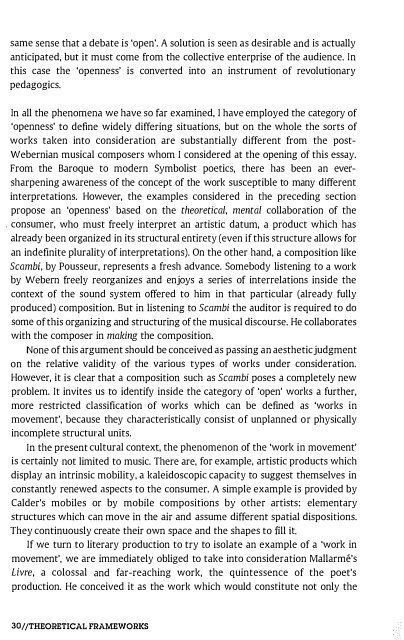You also want an ePaper? Increase the reach of your titles
YUMPU automatically turns print PDFs into web optimized ePapers that Google loves.
same sense that a debate is 'open'. A solution is seen as desirable and is actually<br />
anticipated, but it must come from the collective enterprise of the audience. In<br />
this case the 'openness' is converted into an instrument of revolutionary<br />
pedagogics.<br />
In all the phenomena we have so far examined, I have employed the category of<br />
'openness' to define widely differing situations, but on the whole the sorts of<br />
works taken into consideration are substantially different from the post<br />
Webernian musical composers whom I considered at the opening of this essay.<br />
From the Baroque to modern Symbolist poetics, there has been an eversharpening<br />
awareness of the concept of the work susceptible to many different<br />
interpretations. However, the examples considered in the preceding section<br />
propose an 'openness' based on the theoretical, mental collaboration of the<br />
. consumer, who must freely interpret an artistic datum, a product which has<br />
already been organized in its structural entirety (even if this structure allows for<br />
an indefinite plurality of interpretations). On the other hand, a composition like<br />
5cambi, by Pousseur, represents a fresh advance. Somebody listening to a work<br />
by Webern freely reorganizes and enjoys a series of interrelations inside the<br />
context of the sound system offered to him in that particular (already fully<br />
produced) composition. But in listening to 5cambi the auditor is required to do<br />
some of this organizing and structuring of the musical discourse. He collaborates<br />
with the composer in making the composition.<br />
None of this argument should be conceived as passing an aesthetic judgment<br />
on the relative validity of the various types of works under consideration.<br />
However, it is clear that a composition such as 5cambi poses a completely new<br />
problem. It invites us to identify inside the category of 'open' works a further,<br />
more restricted classification of works which can be defined as 'works in<br />
movement', because they characteristically consist of unplanned or physically<br />
incomplete structural units.<br />
In the present cultural context, the phenomenon of the 'work in movement'<br />
is certainly not limited to music. There are, for example, artistic products which<br />
display an intrinsic mobility, a kaleidoscopic capacity to suggest themselves in<br />
constantly renewed aspects to the consumer. A simple example is provided by<br />
Calder'S mobiles or by mobile compositions by other artists: elementary<br />
structures which can move in the air and aSsume different spatial dispositions.<br />
They continuously create their own space and the shapes to fill it<br />
If we turn to literary production to try to isolate an example of a 'work in<br />
movement', we are immediately obliged to take into consideration Mallarme's<br />
Livre, a colossal and far-reaching work, the quintessence of the poet's<br />
production. He conceived it as the work which would constitute not only the<br />
30/ /THEORETICAL FRAMEWORKS








